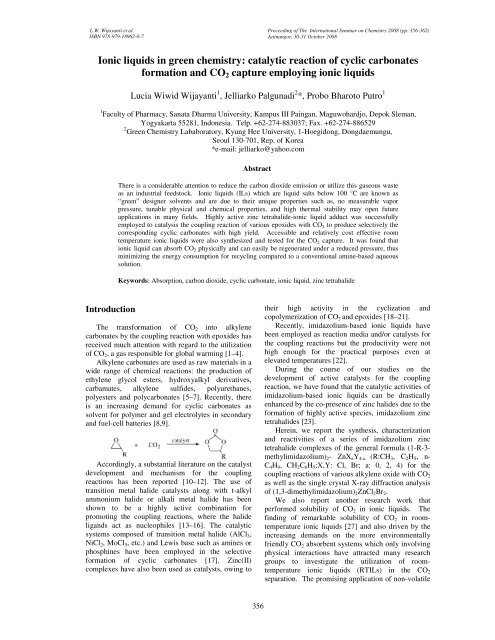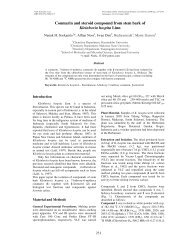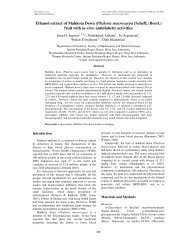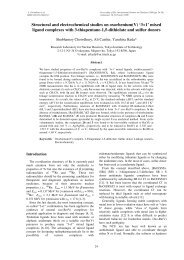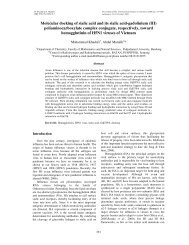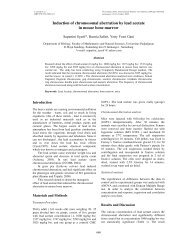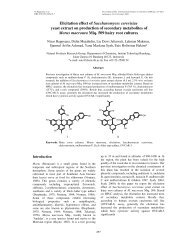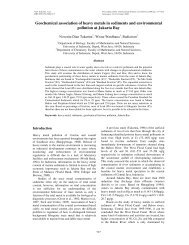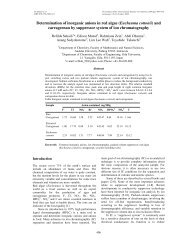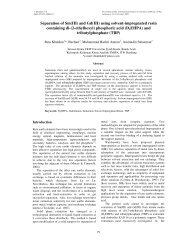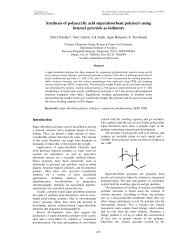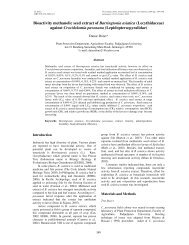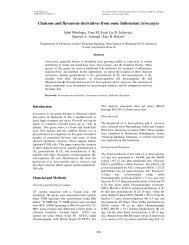Ionic liquids in green chemistry: catalytic reaction of cyclic ...
Ionic liquids in green chemistry: catalytic reaction of cyclic ...
Ionic liquids in green chemistry: catalytic reaction of cyclic ...
You also want an ePaper? Increase the reach of your titles
YUMPU automatically turns print PDFs into web optimized ePapers that Google loves.
L.W. Wijayanti et al. Proceed<strong>in</strong>g <strong>of</strong> The International Sem<strong>in</strong>ar on Chemistry 2008 (pp. 356-362)Jat<strong>in</strong>angor, 30-31 October 2008ambiguous spectroscopic and elemental analysis dataled us to carry out s<strong>in</strong>gle crystal X-ray diffractionstudy, which revealed that the white powder was[Dmim] 2 ZnCl 2 Br 2 . The crystals <strong>of</strong> [Dmim] 2 ZnCl 2 Br 2were grown <strong>in</strong> a DMSO/toluene solvent mixture atroom temperature. An ORTEP <strong>of</strong> its molecularstructure is shown <strong>in</strong> Fig. 1, where selected bonddistances and angles are also provided.The crystal <strong>of</strong> [Dmim] 2 ZnCl 2 Br 2 conta<strong>in</strong>s two<strong>in</strong>dependent molecules <strong>in</strong> the asymmetric-crystal unit.Each z<strong>in</strong>c center is surrounded by four halide ligandsand possesses a distorted tetrahedral ligandenvironment. Unfortunately, the exact position <strong>of</strong>bromide and chloride <strong>in</strong> tetrahedral z<strong>in</strong>c center couldnot be determ<strong>in</strong>ed due to a disorder <strong>in</strong> the crystalsystem. Interest<strong>in</strong>gly, two imidazolium cations werepaired with a tetrahalo z<strong>in</strong>cate dianion ([ZnBr 2 Cl 2 ] 2- )<strong>in</strong> the solid state.In order to confirm that [Dmim] 2 ZnCl 2 Br 2 is areal-active species for the coupl<strong>in</strong>g <strong>reaction</strong>performed <strong>in</strong> the presence <strong>of</strong> [Dmim]Br and ZnCl 2 ,the activity <strong>of</strong> [Dmim] 2 ZnCl 2 Br 2 was compared withthat <strong>of</strong> the <strong>catalytic</strong> system composed <strong>of</strong> [Dmim]Brand ZnCl 2 for the coupl<strong>in</strong>g <strong>reaction</strong> <strong>of</strong> CO 2 andethylene oxide at 100 °C and 500 psig with a molarratio <strong>of</strong> EO/Zn = 500.As can be seen <strong>in</strong> Table 1, [Dmim] 2 ZnCl 2 Br 2 wasfound to exhibit the similar activity to the <strong>catalytic</strong>system consist<strong>in</strong>g <strong>of</strong> [Dmim]Br and ZnCl 2 . The activespecies, [Dmim] 2 ZnCl 2 Br 2 was obta<strong>in</strong>ed <strong>in</strong> high yieldover 90% either by react<strong>in</strong>g [Dmim]Br with ZnCl 2 orfrom the <strong>reaction</strong> <strong>of</strong> [Dmim]Cl and ZnBr 2 , suggest<strong>in</strong>gthat bromide and chloride anions <strong>in</strong> [Dmim] 2 ZnCl 2 Br 2can be exchanged. Other imidazolium z<strong>in</strong>c complexeswere similarly prepared.The <strong>catalytic</strong> activity <strong>of</strong> [Dmim] 2 ZnCl 2 Br 2 wasevaluated for the coupl<strong>in</strong>g <strong>reaction</strong>s <strong>of</strong> CO 2 andvarious alkylene oxide to produce correspond<strong>in</strong>galkylene carbonates, and the results are listed <strong>in</strong> Table2. Most <strong>of</strong> the alkylene oxides tested were readilyconverted to the correspond<strong>in</strong>g alkylene oxides butthe reactivity <strong>of</strong> alkylene oxide was greatly affectedby the substituent at the carbon atom <strong>of</strong> the epoxide.358
L.W. Wijayanti et al. Proceed<strong>in</strong>g <strong>of</strong> The International Sem<strong>in</strong>ar on Chemistry 2008 (pp. 356-362)Jat<strong>in</strong>angor, 30-31 October 2008Ethylene oxide and alkylene oxides with lessbulkier substituents, produced correspond<strong>in</strong>g alkyleneoxides <strong>in</strong> high yields. However, alkylene oxides withbulky substituents around epoxide groups gave muchlower yields <strong>of</strong> alkylene carbonates. This can beclearly seen by compar<strong>in</strong>g the reactivities <strong>of</strong> 1,2-epoxybutane, glycidylisopropyl ether and t-butylglycidyl ether. The most crowded t-butylglycidylether showed the lowest reactivity while the leastcrowded 1,2-epoxybytane exhibited the highestreactivity. The steric crowdness around epoxide groupis likely to prevent the coord<strong>in</strong>ation <strong>of</strong> alkylene oxideto z<strong>in</strong>c center. The lower reactivities <strong>of</strong>epicholorohydr<strong>in</strong> and hexafluoropropylene oxide <strong>in</strong>comparison with propylene oxide can be largelyattributed to the electron-withdraw<strong>in</strong>g effects <strong>of</strong>chlor<strong>in</strong>e and fluor<strong>in</strong>e atoms. The presence <strong>of</strong> highlyelectronegative substituent reduces the electrondensity on the oxygen atom <strong>of</strong> epoxide, and thereforethe ability <strong>of</strong> epoxide to coord<strong>in</strong>ate to z<strong>in</strong>c centerbecome reduced, which is presumed to be the firststep <strong>in</strong> the coupl<strong>in</strong>g <strong>reaction</strong>. The reason for therelatively lower reactivity <strong>of</strong> styrene oxide seems tobe a comb<strong>in</strong>ation <strong>of</strong> steric and electronic effect <strong>of</strong>phenyl group.Various imidazolium z<strong>in</strong>c tetrahalide complexeswere tested for their activities <strong>in</strong> the coupl<strong>in</strong>g<strong>reaction</strong>s <strong>of</strong> CO 2 and alkylene oxides (Table 3).The activities <strong>of</strong> imidazolium z<strong>in</strong>c tetrahalideswere not significantly affected by the variation <strong>of</strong>imidazolium cations. On the other hand, the activitieswere greatly <strong>in</strong>fluenced by halide groups bonded toz<strong>in</strong>c center. From these results, it is likely that theimidazolium cation only plays a role <strong>in</strong> stabiliz<strong>in</strong>g anactive z<strong>in</strong>c tetrahalide dianion and not <strong>in</strong> controll<strong>in</strong>gthe activity.The dissociation <strong>of</strong> a halide ion from the z<strong>in</strong>ctetrahalide dianion and the follow<strong>in</strong>g attack <strong>of</strong> thehalide ion on the carbon atom <strong>of</strong> the epoxide wouldtake place more easily with more nucleophilicbromide ion, giv<strong>in</strong>g the follow<strong>in</strong>g activity order:[ZnBr 4 ] 2- > [ZnBr 2 Cl 2 ] 2- >> [ZnCl4] 2-CO 2 solubility measurementsIn another research work, we also performedsolubility test <strong>of</strong> CO 2 <strong>in</strong> ionic <strong>liquids</strong>. We <strong>in</strong>vestigatedthe physical properties <strong>of</strong> dialkylimidazoliumdialkylphosphates. The products <strong>of</strong> synthesis 1,3-dimethylimidazoliumdimethylphosphate/[MMIM][Me 2 PO 4 ], 1-ethyl-3-methyl-imidazolium diethylphosphate/[EMIM][Et 2 PO 4 ], and 1-butyl-3-methyl-imidazoliumdibutylphosphate/[BMIM][Bu 2 PO 4 ] estimateddensities at 313.15, 323.15, and at 333.15 K are listed<strong>in</strong> Table 4. A cation with a long alkyl cha<strong>in</strong>-length359
L.W. Wijayanti et al. Proceed<strong>in</strong>g <strong>of</strong> The International Sem<strong>in</strong>ar on Chemistry 2008 (pp. 356-362)Jat<strong>in</strong>angor, 30-31 October 2008substituent has low density might be due to entropicreasons, as the density <strong>of</strong> IL decreases with <strong>in</strong>creas<strong>in</strong>galkyl cha<strong>in</strong>-length; therefore, there may be more freevolume with<strong>in</strong> the longer alkyl cha<strong>in</strong> IL [33]. Thedensities <strong>of</strong> all tested RTILs are little <strong>in</strong>fluenced bytemperature variations and are decreased astemperature <strong>in</strong>creased.Solubility measurements were performed at closeto and slightly above atmospheric pressure at 313.15,323.15, and 333.15 K and the amount <strong>of</strong> dissolvedsolute was calculated based on a pressure-decayobservation. The CO 2 solubility on a mole fractionand a volume basis and the CO 2 equilibrium pressuresabove the liquid absorbent are listed <strong>in</strong> Figure 2, 3,and 4. As can be seen, the CO 2 solubility <strong>in</strong>creasesl<strong>in</strong>early with pressure <strong>in</strong> all <strong>of</strong> the dialkylimidazoliumdialkylphosphate ionic liquid coefficients <strong>of</strong> theRTILs show positive deviations from the Raoult’s lawliq<strong>in</strong> that they are greater than 0.5 f 2or 2.44 MPa [34]Table 4 Room-temperature ionic <strong>liquids</strong> synthesized <strong>in</strong> this study, their structures, and experimental densities (ρ)EntryCompoundOO P1 N N OOρ/kg·m -3 (ρ = ± 0.0001)313.15 K 323.15 K 333.15 K1.2510 1.2444 1.2380[MMIM][Me 2 PO 4 ]OOPOC 2 H 52 C 2 H 5 N N OC 2 H 5[EMIM][Et 2 PO 4 ]OC 4 H 9O P O3 C 4 H 9 N N OC 4 H 9[BMIM][Bu 2 PO 4 ]1.1386 1.1321 1.12551.0400 1.0337 1.027110 3 x21816141210864200 50 100 150 200p/kPaFigure 2 Solubility <strong>of</strong> CO 2 <strong>in</strong> [MMIM][Me 2 PO 4 ]at (●) 313.15 K, (■) 333.15 K, and (▲)323.15 K at atmospheric pressure10 3 x23025201510500 50 100 150 200 250p/kPaFigure 3 Solubility CO 2 <strong>in</strong> [EMIM][Et 2 PO 4 ] at (●)313.15 K, (■) 333.15 K, and (▲) 323.15 K atatmospheric pressure360
L.W. Wijayanti et al. Proceed<strong>in</strong>g <strong>of</strong> The International Sem<strong>in</strong>ar on Chemistry 2008 (pp. 356-362)Jat<strong>in</strong>angor, 30-31 October 2008Table 5 List <strong>of</strong> variation <strong>of</strong> Henry’s law coefficient with temperature <strong>of</strong> 1-3-dialkylimidazolium dialkylphosphate ionic <strong>liquids</strong>Compound T/K H 21 /MPa Error a313.15 10.64 0.12[MMIM][Me 2 PO 4 ] 323.15 12.72 0.03333.15 15.22 0.15313.15 6.99 0.03[EMIM][Et 2 PO 4 ] 323.15 8.12 0.04333.15 9.66 0.02313.15 4.98 0.02[BMIM][Bu 2 PO 4 ] 323.15 5.76 0.02333.15 6.85 0.03a Standard errors <strong>of</strong> the isotherm slopes10 3 x240353025201510500 50 100 150 200p/kPaFigure 4 Solubility CO 2 <strong>in</strong> [BMIM][Bu 2 PO 4 ] at (●)313.15 K, (■) 333.15 K, and (▲) 323.15 Kat atmospheric pressureIn our experiments, the Henry’s law coefficient at aspecified temperature was estimated from the slope <strong>of</strong>a l<strong>in</strong>ear fit <strong>of</strong> the CO 2 solubility <strong>in</strong> mole fractionversus fugacity. The Henry’s law coefficients atvarious temperatures and the standard error <strong>of</strong> theisotherm slopes are given <strong>in</strong> the Table 5. As can beseen, all <strong>of</strong> the Henry’s law.ConclusionsA series <strong>of</strong> ionic liquid-based imidazolium z<strong>in</strong>ctetrahalide and (1-R-3-methylimidazolium) 2 ZnX 2 Y 2 ,were prepared by react<strong>in</strong>g ZnX 2 with (1-R-3-methylimidazolium)Y.The s<strong>in</strong>gle crystal X-ray structural analysis andelemental analysis <strong>of</strong> (1,3-dimethylimidazolium) 2ZnBr 2 Cl 2 revealed that two imidazolium cations werepaired with a dibromodichloro z<strong>in</strong>cate dianion.The <strong>catalytic</strong> activities <strong>of</strong> imidazolium z<strong>in</strong>ctetrahalide were evaluated for the coupl<strong>in</strong>g <strong>reaction</strong>s<strong>of</strong> epoxides and CO 2 , and the effects <strong>of</strong> halide ions,imidazolium cations, temperature and pressure were<strong>in</strong>vestigated. The <strong>catalytic</strong> activity <strong>of</strong> (1-R-3methylimidazolium) 2 ZnX 2 Y 2 was found to <strong>in</strong>creasewith <strong>in</strong>creas<strong>in</strong>g nucleophilicity <strong>of</strong> halide ion. But, thesubstitution on the imidazolium cation showed anegligible effect on the <strong>catalytic</strong> activity. Theformation <strong>of</strong> <strong>cyclic</strong> carbonate was strongly dependenton the temperature but <strong>in</strong>dependent <strong>of</strong> the pressure <strong>of</strong>CO 2 . The reactivity <strong>of</strong> alkylene oxide was greatlyaffected by the substituent at the carbon atom <strong>of</strong> theepoxide. Ethylene oxide and alkylene oxides with lessbulkier substituents produced correspond<strong>in</strong>g alkyleneoxides <strong>in</strong> high yields. However, alkylene oxides withbulky or electron-withdraw<strong>in</strong>g substituents aroundepoxide groups gave much lower yields <strong>of</strong> alkylenecarbonates.The CO 2 solubility <strong>in</strong>creases l<strong>in</strong>early with pressure<strong>in</strong> all <strong>of</strong> the dialkylimidazolium dialkylphosphateionic <strong>liquids</strong> and decreases as temperature <strong>in</strong>creases.It means that dialkylimidazolium dialkylphosphatehave capability to capture CO 2 through physical<strong>in</strong>teraction.AcknowledgementsThis work was supported by the M<strong>in</strong>istry <strong>of</strong>Environment <strong>in</strong> Korea and presented by Ms. LuciaWiwid Wijayanti, M.SiReferencesA. Behr, Carbon Dioxide Activation by MetalComplexes, VCH, New York, 1988.D.J. Darensbourg, M.W. Holtcamp, Coord. Chem.Rev. (1996) 153.T. Kim, S. Vijayalakshmi, S. Son, S. Ryu, J. Kim, J.Ind. Eng. Chem. 9 (2003) 481–487.B. Sea, Y. Park, K. Lee, J. Ind. Eng. Chem. 8 (2002)290–296.M. Aresta, E. Quaranta, ChemTech. Mar. (1997) 32–40.A.G. Shaikh, Chem. Rev. 96 (1996) 951–976.D. Lee, J. Hur, B. Kim, S. Park, D. Park, J. Ind. Eng.Chem. 9 (2003) 513–517.J.J. Lagowski, The Chemistry <strong>of</strong> NonaqueousSolvents, Academic Press, New York, 1976.M. Inaba, Z. Siroma, A. Funabiki, M. Asano,Langmuir 12 (1996) 1535–1540.361
L.W. Wijayanti et al. Proceed<strong>in</strong>g <strong>of</strong> The International Sem<strong>in</strong>ar on Chemistry 2008 (pp. 356-362)Jat<strong>in</strong>angor, 30-31 October 2008D. Ji, X. Ju, R. He, Appl. Catal. A 203 (2000) 329–333.H. Kawanami, Y. Ikushima, Chem. Commun. (2000)2089–2090.J. Gao, S. Zhong, J. Mol. Catal. A (2001) 168.H. Matzuda, A. Niangawa, R. Nomura, Chem. Lett.(1979) 1261–1262.R. Nomura, A. N<strong>in</strong>agawa, H. Matsuda, J. Org. Chem.45 (1980) 3735–3738.H. Kisch, R. Mill<strong>in</strong>i, I.J. Wang, Chem. Ber. 119(1986) 1090–1094.W. Du¨mler, H. Kisch, Chem. Ber. 123 (1990) 277–283.M. Ratzenh<strong>of</strong>er, H. Kisch, Angew. Chem. Int. Ed.Engl. 19 (1980) 317–318.D.J. Darensbourg, M.W. Holtcamp, Macromolecules28 (1995) 7577–7579.M. Cheng, E.B. Lobkovsky, G.W. Coates, J. Am.Chem. Soc. 120 (1998) 11018–11019.M. Cheng, D.R. Moor, J.J. Reczek, B.M.Chamberla<strong>in</strong>, E.B. Lobkovsky, G.W. Coates, J.Am. Chem. Soc. 123 (2001) 8738-8749.R.L. Paddock, S.T. Nguyen, J. Am. Chem. Soc. 123(2001) 11498–11499.J. Peng, Y. Deng, New J. Chem. 25 (2001) 639–641.H.S. Kim, J.J. Kim, H. Kim, H.G. Jang, J. Catal. 220(2003) 44–46.M. Hasan, I.V. Kozhevnikov, M.R.H. Siddiqui, A.Ste<strong>in</strong>er, N. W<strong>in</strong>terton, Inorg. Chem. 38 (1999)5637–5641.J.S. Wilkes, J.A. Levisky, R.A. Wilson, C.L. Hussey,Inorg. Chem. 21 (1982) 1263–1264.P.J. Dyson, M.C. Grossel, N. Sr<strong>in</strong>ivasan, T. V<strong>in</strong>e, T.Welton, D.J. Williams, A.J.P.White, T. Zigras, J.Chem. Soc., Dalton Trans. (1997) 3465–3469.L.A. Blanchard, D. Hancu, E.J. Beckman, J.F.Brennecke, Nature 399 (1999) 28-29.J.D. Holbrey, W.M. Reichert, R.P. Swatloski, G.A.Broker, W.R. Pitner, K.R. Seddon, R.D. Rogers,Green Chem. 4 (2002) 407-413.C.J. Bradaric, A. Downard, C. Kennedy, A.J.Robertson, Y. Zhou, Green Chem. 5 (2003) 143-152.E. Kuhlmann, S. Himmler, H. Giebelhaus, P.Wasserscheid, Green Chem. 9 (2007) 233-242.Y. Zhou, A.J. Robertson, J.H. Hillhouse, D.Baumann, Cytec Canada Inc., WO, 2004,2004016631.R.P. Swatloski, J.D. Holbrey, R.D. Rogers, GreenChem. 5 (2003) 361-363.L.A. Blanchard, Z. Gu, J.F. Brennecke, J. Phys.Chem. B. 105 (2001) 2437-2444.P. Scovazzo, D. Camper, J. Kieft, J. Poshusta, C.Koval, R. Noble, Ind. Eng. Chem. Res. 43 (2004)6855-6860.362


